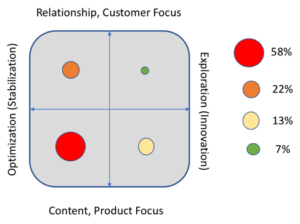![]() Leading companies in the Information Age is like driving 200 kilometers per hour. Everything happens at an accelerated pace that can leave employees exhausted. What if you could inject a new source of fuel into the workforce to boost its agility? The good news is that it’s possible to revive tired companies by deploying four types of untapped energy potential: innovation, optimization, social and elemental.
Leading companies in the Information Age is like driving 200 kilometers per hour. Everything happens at an accelerated pace that can leave employees exhausted. What if you could inject a new source of fuel into the workforce to boost its agility? The good news is that it’s possible to revive tired companies by deploying four types of untapped energy potential: innovation, optimization, social and elemental.
Energy fuels all living things — that includes organizations. Humans, the seasons of the year, and companies share a common life cycle: birth, growth, maturity, and decline. Importantly, for an organization to survive, it must jump onto a new growth curve before reaching the end of its decline phase. Companies that complete the jump, like Amazon, survive, while others that don’t, like Blockbuster, fail. Any company can find new life with four types of energy potential: innovation, optimization, social and elemental.
Each employee has a natural predisposition towards either exploration (innovation) or optimization (efficiency). They also prefer to interact socially (with people) or elementally (with things or systems). Employers need energy in the right place to maximize their current strategy, and employees want to be in roles where they deploy their natural preferences most powerfully. When strategy and strengths are aligned, talent retention improves, and potential is actualized.
| Type of Energy | Employee Preferences | Employee Strengths | How to Activate Potential |
| Innovation Energy | Exploration, change, movement | • Creating new ideas and methods • Adapting easily to change |
• Energized most with projects in the inception or concept phase • Work well in early stages of the growth cycle (birth, growth)• Provide the opportunities for risk taking and change |
| Optimization Energy | Efficiency, structure, scalability | • Standardizing processes • Expanding and growing existing ideas• Identifying risks and protecting current brand |
• Most productive with refining and improving existing products or services • Work well in the later stages of the growth cycle (maturity, decline)• Provide a stable work environment where employees are rewarded for finding risks, efficiencies, and improvements |
| Social Energy | Interacting with people | • Developing relationships • Working in teams• Picking up on subtle social cues |
• Most productive when working with people • Provide opportunities for networking, socializing, teamwork, and conduct training in person |
| Elemental Energy | Interacting with things, systems, or content | • Working with the things or systems • Research and hands on work with products or services |
• Energized most when working with things, data, or systems • Provide opportunities to do training on-line, work remotely, develop or improve content, and test ideas |
Traditional leadership psychometric instruments focus on engaging employees through improving communications and mutual understanding (Myers-Briggs, StrengthsFinder, DISC, Predictive Index etc.) In recent history, psychometric models have expanded to incorporate more modern ethological and cybernetic considerations. These more complex models adapt as technology improves and society evolves. That means that with new tools like the AEM-Cube, leaders may easily identify “heat maps” of what naturally motivates energy individuals, teams, and entire organizations. Identifying preferences, and igniting their potential, leads to engaging employees most powerfully and ultimately, increases profitability.
Companies like Apple, IBM, Phillips, and Heineken are already using the AEM-Cube tool to tap into new sources of energy. The heat map below represents data that may be gleaned from the AEM-Cube tool. This illustration is similar to that of a large U.S. engineering company.
 Assume this company wanted to innovate with a completely new product or service that had never been tried before. Leadership tried various ideation programs to little avail. Upon identifying where its employees’ energy potential exists, this organization now realizes that:
Assume this company wanted to innovate with a completely new product or service that had never been tried before. Leadership tried various ideation programs to little avail. Upon identifying where its employees’ energy potential exists, this organization now realizes that:
• 80% of its employees prefer optimization to innovation. In other words, they get into action by creating efficiencies, refining, stabilizing, and executing existing processes. While still capable of innovating, their ideas come from experience and evidence. These employees also naturally shine at Kaizen, Lean Six Sigma, or continuous improvement initiatives as well as scaling up and stabilizing existing ideas.
• 71% of employees exhibit elemental energy, preferring to focus on the product, technology, or content side of the business. They naturally thrive in systems development or product improvement.
Understanding an organization’s heatmap is the first step to identifying energy potential that is often at best underexploited, or at worst, ignored completely. For example, employees with all types of energy potential are capable of innovating, but those who naturally prefer exploration will look for ideas that have not been tried before and require less structure to get into action. To successfully innovate, the engineering company represented by this heatmap would need a proven process with clearly defined expectations. Preferably, it would also involve product, technologies or systems development as the topics around which to focus ideation efforts.
Tired companies can speed up the pace and increase agility by finding and deploying the right fuel. Once an organization understands what energizes its employees, it can tap into unused potential to race to the head of the pack.
